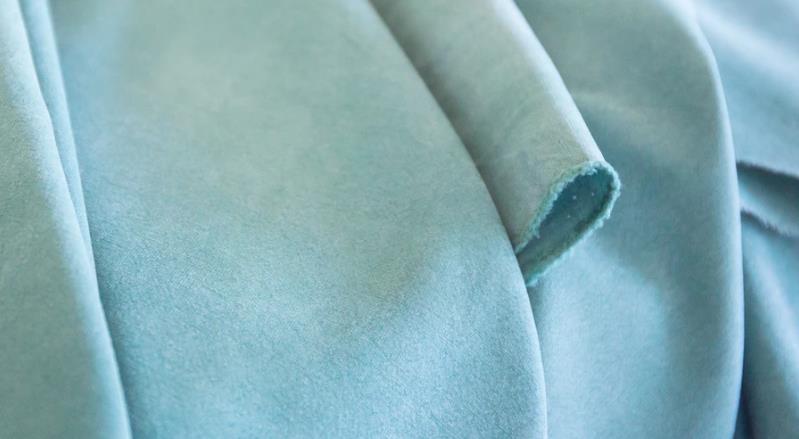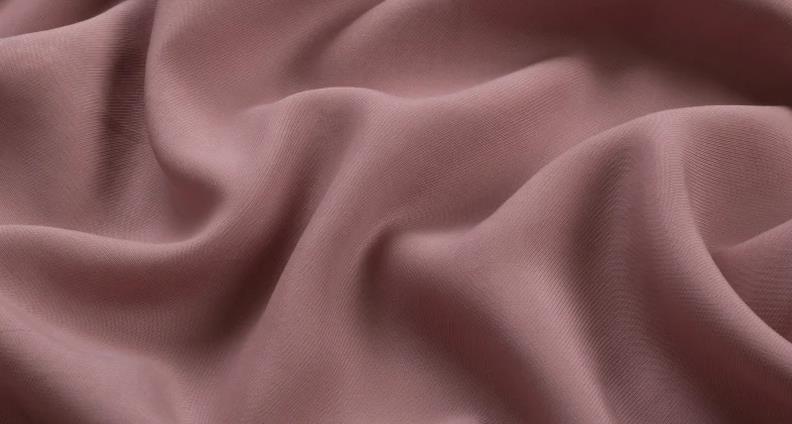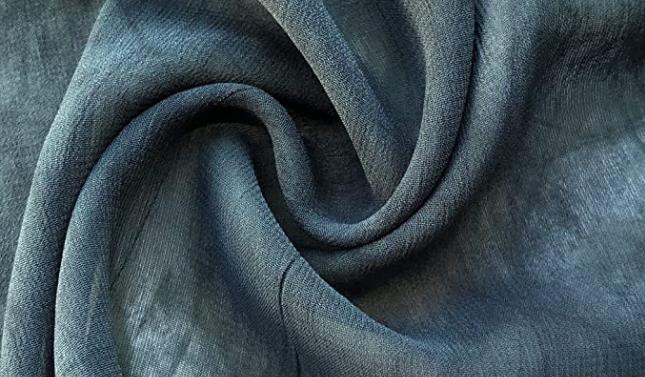Lyocell resulted from a global industry-wide effort to discover more ways to create synthetic fabric. This time, the inventors of lyocell managed to create something that was half organic, half manufactured.
Do you have this fascinating fabric in your wardrobe? This article will take an in-depth look at lyocell and its properties, history, and more!
What is Lyocell Fabric?

Lyocell fabric is a textile made from tree cellulose. It is a part of the rayon family of fabrics. You may also know the fabric through the brand name “Tencel.”
The term “lyocell” actually refers more to the lyocell process. This process is a unique technique where chemicals are used to dissolve wood and extract the cellulose without making any significant changes to the chemical make-up of the substance.
It is considered one of the most environmentally friendly synthetic fabrics in the market. Today, it is used in various applications, including commercial clothing and industrial purposes.
How is Lyocell Fabric Made?
Lyocell is produced through a direct dissolving process without the involvement of a derivative. This sets it apart from rayon production, which follows a different manufacturing process.
As mentioned, lyocell is a semi-synthetic, with its primary raw material being cellulose from tree wood.
The wood preparation for cellulose extraction is also an essential part of how lyocell fabric is made. Hardwood trees specially propagated for lyocell production are cut down and debarked. The fresh logs are sent to a wood chipper which cuts them into small pieces.
The chips are sent to a bath of digesters. These chemicals make short work of the wood, and the resulting cellulose solution is dried into large sheets. This is where the lyocell production process starts.
The Production Process
Lyocell fabric goes through the following steps of production.
Extracting the Cellulose from Wood
After the wood has been prepared into a wet pulp and rolled into thick cellulose sheets, it is time to dissolve them. Once unrolled, the cellulose will be broken down into one-by-one-inch squares. There are then treated with amine oxide.
Filtering and Spinning
After some time has passed, the cellulose will completely dissolve and become a clear liquid. To ensure the solution is complete, the batch is filtered. It goes through spinnerets, where the formation of the threads begins.
The spinning process begins, and the cellulose goes through small holes in the spinneret to become long strands. They also go through another amine oxide bath.
Washing and Drying
Once they have become long strands, the cellulose fibers are washed using demineralized water.
It is then sent through the drying stage. A lubricant like silicone is applied to make carding easier.
Carding
A typical process in producing threads and fabrics, the cellulose fibers are then ensured to be separated from one another.
Finishing
The lyocell fibers are now finished and spooled. They can now be used to create lyocell products or blend them with other fibers to create a wide variety of items.
How is Lyocell Fabric Used?
Lyocell is used for a variety of apparel and industrial purposes.
Apparel
Lyocell is typically used as an alternative for cotton or even silk fabric. Some garments are blended with other fibers to attain the strength of lyocell and the characteristics of the other fibers. It has been used in both casual fast-fashion, boutique, and luxury brands.
Industrial
Due to its durable nature, lyocell has been used in automotive filters, conveyor belts, ropes, and protective suits.
Medical
Lyocell’s light and breathable organic composition make it an ideal bandage fabric. Its high tensile strength, even when wet, has its advantages and its high absorbency factor.
Where is Lyocell Fabric Produced?
The first creation of lyocell was in the United States; however, today, several specialized plants produce the same kind of fabric, albeit under different brand names.
You can find brands in the US, Europe, Russia, Korea, and Japan all have their spin on the lyocell fabric and labeled them with different names, with slight variations.
Of the companies that produce lyocell, Austria’s Lenzing is most significant in the production. They supply 130,000 metric tons of fiber for the global market. Their largest factories for lyocell are located in China, and thus most of the production comes from the country.
How Much Does Lyocell Fabric Cost?
Due to the intensive and specialized manufacturing process for lyocell fabric, the textile is significantly more expensive than many organic and synthetic fibers. Garments and other items made of 100% lyocell would be even more costly than the typical blends you would see on the market.
What Different Types of Lyocell Fabric are There?

While lyocell is technically a rayon and doesn’t have “types,” it’s worth delving into the different kinds of similar fabric created by other manufacturers.
- Tencel by Courtaulds (USA); meant for apparel applications
- Courtaulds Lyocellby Courtaulds (USA); meant for technical textiles
- Tencel A 100by Courtaulds (USA); non-fibrillating fibers
- Lenzing Lyocellby Lenzing (Austria); glossy staple fibers
- Lyocell Microby Lenzing (Austria); fine diameter fibers
- Newcell by Akzo-Nobel (Germany); glossy and matte filament yarns
- ALCERU by TITK (Germany); pilot plant for staple filaments
- ORCEL by Russian Res. Inst. (Russia); experimental production
- Cocell by Hanil Synthetic (Korea)
- Schwarza-Lyocellby Thuringiscches Instituude and Zimmer A.G. (Germany); staple fiber
- Visage by Omori Kikau Co. Ltd (Japan); multi-sided staple fiber
As you can see, several manufacturers worldwide have produced their version of the tree cellulose fabric with their brand names. However, the process to create these fabrics is still very similar.
How Does Lyocell Fabric Impact the Environment?
While Lyocell has the advantage of using a natural tree cellulose component, its process still uses chemicals and intensive energy usage.
Still, lyocell is not a bad alternative to choose for consumers who are concerned for the environment. Unfortunately, lyocell garments are sometimes used as a decoy for greenwashing companies.
Advantages of Lyocell
Lyocell is one of the most sustainable alternative fabrics in the market today. It boasts a lot of positive characteristics and an ecologically focused supply chain.
Its characteristics make it versatile and excellent for all climates worldwide. Its breathability and moisture-wicking capabilities make it great for everyday use.
Disadvantages of Lyocell
Lyocell is often used in various blends with synthetic fabrics. This makes lyocell blend fabrics challenging to recycle and compost.
While reputable brands and manufacturers produce lyocell, pure lyocell garment still costs slightly more than regular cotton fabric, and the process still requires a significant amount of energy.
Is Lyocell Better than Cotton?
It all depends on individual preference. The two fabrics are equally soft, breathable, and durable, and the difference in cost can be negligible for the most part, depending on the garment or accessories you are considering. Lyocell has the advantage of coming from a more sustainable textile industry sector.
Is Lyocell a Natural Fiber?
While lyocell is made from natural materials, namely wood pulp, and can be certified organic in some situations, it is still labeled as a semi-synthetic fabric. This is because of the oxides and chemicals used in the production process – because they need to be used to create lyocell, you cannot classify it as a natural fiber.
Is Lyocell Stretchy?
Since it is made from tree cellulose, an organic material, you can expect limited stretches like cotton or silk. While lyocell does provide a slight stretch – enough for you to fit into your clothes nicely – they won’t stretch as much as synthetics like nylon or spandex.
How to Iron Lyocell?
Lyocell tends to stay wrinkle-free, especially when leaving the garment hanging free. However, if there are wrinkles on your lyocell clothes, you are safe to use an iron on them. Use a low setting or even a steamer to address the wrinkles, and they should come out quickly.
How to Wash Lyocell Fabric
Lyocell is durable, but it requires a little more TLC than cotton. One of its best features is that it has a considerable tensile strength even while wet. It can either be hand washed or machine washed. Like most fabrics, expect some slight shrinkage upon the first wash.
Does Lyocell Make You Sweat?

Since Lyocell is made from wood pulp and is a light, breathable fabric, it should not be sweatier than synthetic fabrics. Not only is it light, but it also has moisture-wicking capabilities that will dry you off, whether you are being active or if you are in a place with a warm climate.
Is Lyocell Breathable?
Yes, lyocell is light and breathable fabric. In fact, many ordinary consumers have difficulty telling lyocell and cotton garments apart. Its breathability results in its anti-odor and anti-bacterial properties, which would lead to less necessary washing. Lyocell clothes are ideal for people in warm climates and the summer.
How Sustainable is Lyocell Fabric?
Compared to other textiles, organic or synthetic, lyocell is considered sustainable. Its use of renewable tree bark and its closed-loop chemical processing make it less harmful to the environment. Plus, lyocell fabrics are durable, should last owners a good amount of time, and should not end up in the landfill quickly.
Conclusion
Lyocell is a versatile fabric that has been found to have a lot of uses to replace most fully-synthetic textiles, thanks to the organic properties it inherits from tree cellulose. Lyocell fabric is a good alternative for the environmentally-minded. Those who want to move on from cotton’s wasteful production process may find lyocell the best option for them.
